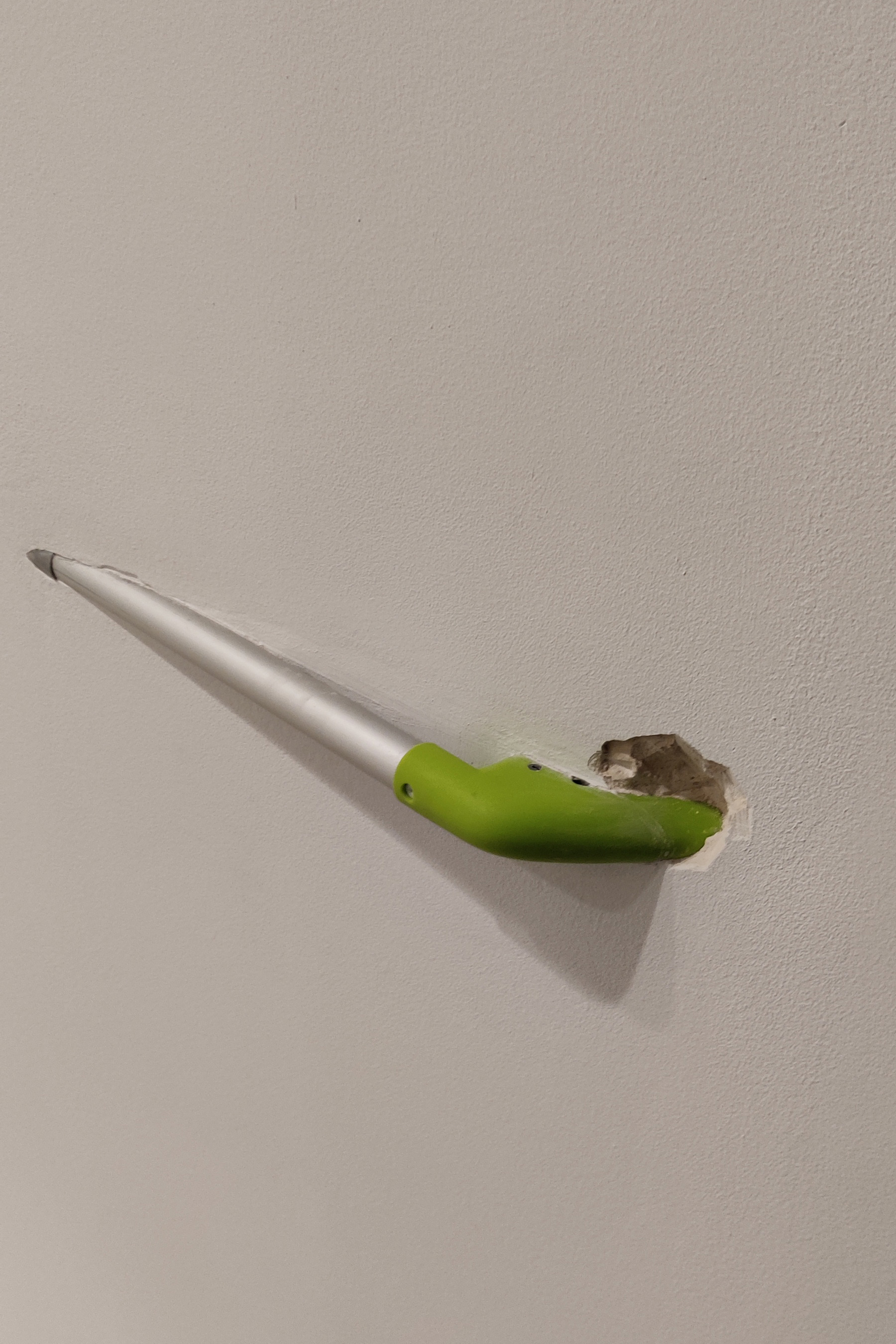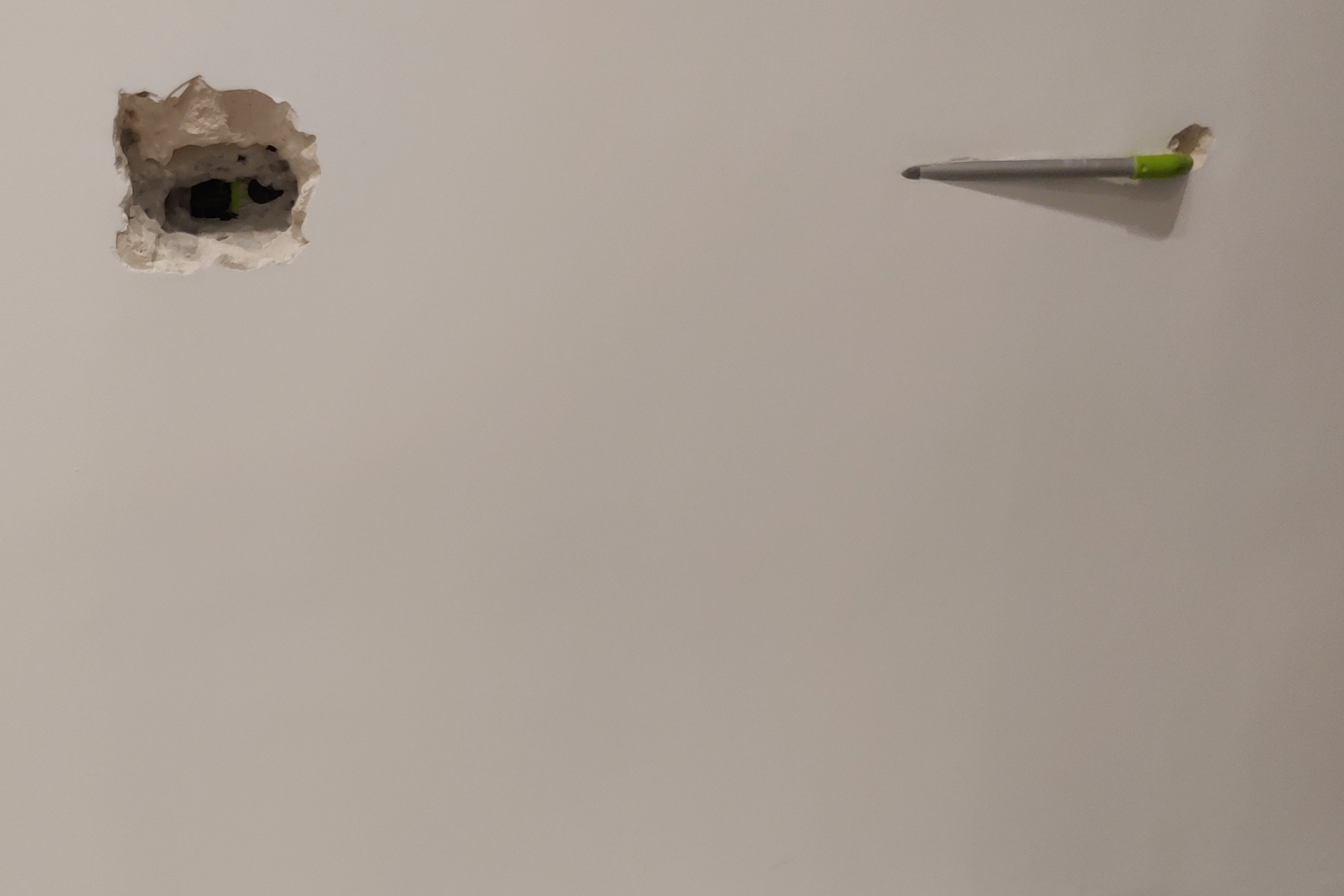GDP (Gross Domestic Product), by Hildigunnur Birgisdóttir
By burying everyday household goods into the pristine new walls of a shining new Moscow art gallery, Icelandic artist Hildigunnur Birgisdóttir questions the sleek finish of the objects - and places - we surround ourselves with, and suggests a slow archaeology allowing us to see our wasteful situation. Written by Will Jennings
It’s not easy to see if the assorted objects are getting
sucked out of the room and into the walls, or if slowly they are emerging from
the fabric of the gallery space. Some are only partially identifiable, their
mass seems to be lost to the architecture leaving just a hint of their
objectness visible within the space, and none of their practicality.
![]()
Hildigunnur Birgisdóttir has buried everyday household goods into the walls of the gallery space at GES-2 in Moscow, a new commission for the show To Moscow! To Moscow! To Moscow!, an exhibition curated Ragnar Kjartansson and Ingibjörg Sigurjónsdóttir.
She ordered household items from online stores like Alibaba, which were delivered to the new Renzo Piano designed gallery and cemented deep into the new walls. Birgisdóttir then turned up in Moscow with a hammer and chisel in hand, then set out to discover the items and reveal them from the neat, white finish of the space.
The dish drying racks, plastic bottles, assorted functional objects seem trapped, inert and withheld from their point of existence. A green handle protrudes from the wall, we may never know what it is attached to. In an Anthropocene age – when objects are disposed of and buried in waste sites sometimes before they have been used a single time, when retailers like Amazon throw away packaged and perfect items just to manage storage, distribution, and demand – these embedded items perhaps feel like slow archaeology, allowing us to observe and discover our current state of obsolescence in real te.
![]()
In the exhibition catalogue, Kjartansson writes: “Hildigunnur is an everyday mystic, deeply in love with the small and the insignificant. The flying debris in the wind of capitalist culture. … Her passion is unlocking the mystery of life. Her odes to the insignificant objects of our consumer-driven culture pose poetic statements about the nature of art and the meaningfulness of everything. She deals with consumer culture in the opposite way to Jeff Koons: she draws your attention to the packaging your smoke detector comes in. Hildigunnur makes us notice real things that we would otherwise miss, things that are – it turns out – made with intent, attention to detail, and even care, but that are deemed insignificant and uninteresting because of their nature or functionality.”
![]()
![]()
![]()
![]()
![]()
![]()
![]()
![]()

fig.i
Hildigunnur Birgisdóttir has buried everyday household goods into the walls of the gallery space at GES-2 in Moscow, a new commission for the show To Moscow! To Moscow! To Moscow!, an exhibition curated Ragnar Kjartansson and Ingibjörg Sigurjónsdóttir.
She ordered household items from online stores like Alibaba, which were delivered to the new Renzo Piano designed gallery and cemented deep into the new walls. Birgisdóttir then turned up in Moscow with a hammer and chisel in hand, then set out to discover the items and reveal them from the neat, white finish of the space.
The dish drying racks, plastic bottles, assorted functional objects seem trapped, inert and withheld from their point of existence. A green handle protrudes from the wall, we may never know what it is attached to. In an Anthropocene age – when objects are disposed of and buried in waste sites sometimes before they have been used a single time, when retailers like Amazon throw away packaged and perfect items just to manage storage, distribution, and demand – these embedded items perhaps feel like slow archaeology, allowing us to observe and discover our current state of obsolescence in real te.

fig.ii
In the exhibition catalogue, Kjartansson writes: “Hildigunnur is an everyday mystic, deeply in love with the small and the insignificant. The flying debris in the wind of capitalist culture. … Her passion is unlocking the mystery of life. Her odes to the insignificant objects of our consumer-driven culture pose poetic statements about the nature of art and the meaningfulness of everything. She deals with consumer culture in the opposite way to Jeff Koons: she draws your attention to the packaging your smoke detector comes in. Hildigunnur makes us notice real things that we would otherwise miss, things that are – it turns out – made with intent, attention to detail, and even care, but that are deemed insignificant and uninteresting because of their nature or functionality.”








figs.iii-x
Hildigunnur Birgisdóttir (b. 1980) is an Icelandic artist whose practice can be seen as an exploration of complex systems through simple or naïve interfaces. Playing with the tensions between our need to create abstract systems of knowledge, and the physical limitations of our own systems of perception, Birgisdóttir’s work wryly reveals the imperfections, eccentricities, and elements of the nonsensical at the intersection of ideal, and human, understanding. These intrusions are not only welcome but fundamental to Birgisdóttir’s work, situating us, unexpectedly, at the centre of our universe. Hildigunnur Birgisdóttir graduated from the Iceland Academy of the Arts in 2003. Her works have been shown at The Reykjavík Art Museum, Kling and Bang, The Living Art Museum, Annaellegallery and i8 gallery.
Will Jennings is a London based writer, visual artist, and educator interested in cities, architecture, and culture. He has written for the RIBA Journal, the Journal of Civic Architecture, Quietus, The Wire, the Guardian, and Icon. He teaches history and theory at UCL Bartlett and Greenwich University, and is director of UK cultural charity Hypha Studios.
www.willjennings.info
images
figx.i-ii Photos by Ivan Erofeev,
© GES-2 House of Culture
figs.ii-x © Will Jennings
publication date
02 February 2022
tags
Archaeology, Capitalism, Domestic, Ges-2 House of Culture, Hildigunnur Birgisdóttir, Will Jennings, Ragnar Kjartansson, Objects, Products, Renzo Piano, Sculpture, Ingibjörg Sigurjónsdóttir
figs.ii-x © Will Jennings
publication date
02 February 2022
tags
Archaeology, Capitalism, Domestic, Ges-2 House of Culture, Hildigunnur Birgisdóttir, Will Jennings, Ragnar Kjartansson, Objects, Products, Renzo Piano, Sculpture, Ingibjörg Sigurjónsdóttir


